Abstract
With the onset of winter in cold regions, border ice begins to form, impacting sediment transport rate and distribution. Understanding the effect of ice cover is crucial in regions with prolonged sub-freezing temperatures, as water bodies remain frozen for a considerable part of the year. While the existing literature includes many studies on sediment transport in open channel flow and several studies on completely ice-covered flow, there is limited research on sediment transport in partially ice-covered channels. Addressing this gap, the current study conducted laboratory experiments in a rectangular flume at the Hydraulics Research and Testing Facility, University of Manitoba, Canada. The investigation focused on examining the influence of asymmetric border ice, varying coverage ratios in asymmetric partially ice-covered flow, and changing flow strengths on bedload transport rate and distribution. Additionally, a comparison was made with symmetric partially ice-covered flow conditions. The findings indicate that the presence of asymmetric border ice indeed affected the bedload transport distribution within the channel, causing non-uniform bedload transport distribution across the channel width, with peak values concentrated in the center of the open flow section. Increased asymmetry in border ice leads to greater asymmetry in bedload transport rate distribution. Despite these pronounced differences in bedload transport rate across the channel width, the cross-section-averaged bedload transport rate could still be estimated utilizing the conventional equations, used for open channel flow, fully ice-covered flow, and symmetric partially ice-covered flow, with the effect of ice cover accounted for by incorporating an additional boundary in the calculation of the wetted perimeter, leading to adjustments in the flow strength.
1. Introduction
Throughout the winter season, ice is commonly found on almost all rivers in northern climates, leading to substantial changes in flow distribution, discharge, water levels, and sediment transport. When temperatures begin to decrease, border ice may form along the riverbanks and gradually extend toward the center of the channel, leading to the formation of a partial ice cover. Also, during midwinter thaw events, the main section of the channel may open up, creating a partial ice cover [1]. Climate change has the potential to increase the duration of partially ice-covered flow in northern rivers by delaying freeze-up and increasing the frequency and duration of mid-winter thaws. Therefore, considering the influence of a partial ice cover becomes essential in fully understanding a river’s sediment budget in specific cases. While previous studies have primarily concentrated on open channel flow and fully ice-covered flow, there has been limited investigation into partially ice-covered flow. It is important to gain insights into border ice impact on river flow, sediment transport, and geomorphology to improve our understanding of how rivers with partial ice covers change over time [2].
Partial ice cover research has mainly relied on experimental measurements due to limitations in field studies and numerical modeling. Field studies encounter challenges due to the transient nature of border ice growth and the fragility of thin ice, which can raise safety concerns in data collection [3]. On the other hand, the lack of sufficient benchmarks for model validation makes numerical modeling challenging. As a result, experimental measurements have emerged as the favored method for understanding partial ice cover phenomena [4,5,6,7]. These studies involve exploring the effects of border ice on flow characteristics [1], turbulent flow behavior [7], shear stress distribution [5], and the influence of bed and ice roughness [4].
Bed sediment motion is a result of the forces applied to individual bed particles (lift, drag, and gravity). The presence of ice cover causes turbulence and a reduction in water drag on the bed [8]. This is mainly because of the additional boundary resistance from the ice cover, leading to raised water levels and a decrease in average velocity and sediment transport rate for the same flow rate. Furthermore, the presence of ice cover can cause lateral flow redistribution, resulting in a varying impact on sediment transport rates at specific locations along the spanwise direction. Therefore, the effect of ice cover on river bed and bank dynamics is complex and variable in different situations [8]. The analysis of partially ice-covered rivers is even more complex because of the concurrent presence of open water and ice cover.
There have been a limited number of studies exploring the impact of ice presence on sediment transport rate. Ettema and Daly [8] provided qualitative insights into how ice cover affects sediment transport by developing a set of dimensionless parameters. Lawson et al. [9] conducted fieldwork, measuring suspended and bedload concentration data during winter and comparing them to data from the summer period. Experimental studies, e.g., Wuebben [10,11], suggested open water theories applying to lower flow layers in ice-covered conditions. Shen and Wang [12] supported conventional relations for bedload transport in ice-covered channels by conducting flume experiments with a floating cover and low-density chips. Additional experimental work has explored the effect of ice on sediment transport rate [13,14]. Ettema et al. [15] conducted a study to assess sediment transport rate and bedforms under the influence of ice. They compared flume data from various studies, including Ettema et al. [16], Sayre and Song [17], and Smith and Ettema [18], with Meyer-Peter and Muller’s [19] and Einstein’s formulas [20], making similar suggestions for sediment transport rate. Few numerical model studies have explored the effects of river ice cover on sediment transport and changes in the riverbed. Notable examples of such studies are those conducted by Carr and Tuthill [21], Kolerski and Shen [22], Manolidis and Katopodes [23], Zhang et al. [24], and Knack [25]. Knack and Shen [26] illustrated the development of a coupled model, which integrates a sediment transport and bed change model with a hydro-thermal-ice dynamics model. To validate the model, laboratory experiments were conducted under open water conditions, as there was a lack of laboratory or quantitative field observations on bed changes under ice conditions.
Rouzegar and Clark [27] investigated the bedload transport rate in a partially ice-covered channel and showed that the conventional equation describing the bedload transport in open channel and fully ice-covered flow was applicable in estimating the total cross-section-averaged bedload transport for partially ice-covered flow. In this equation, the dimensionless bedload transport rate was related to flow strength, and an empirical coefficient for this equation was derived from experimental data. They also investigated the bedload transport distribution influenced by different extents of ice cover and compared the result with open channel and fully ice-covered flow. In a qualitative experimental study, Rouzegar and Clark [28] investigated the effect of asymmetric border ice on bedload transport distribution, considering that border ice in nature does not always follow a symmetric pattern. The current study aims to build on previous work, and for the first time quantify the effect of asymmetric border ice on bedload transport rate and distribution. Results are compared with symmetric border ice conditions as well as open channel flow conditions, and the dramatic differences in specific channel locations are highlighted.
2. Methodology
A 14-m-long, 1.2-m-wide flume was constructed using high-density overlay (HDO) plywood with a bed slope of 0.26% for the experiments (Figure 1). The simulated ice cover was made of flexible plastic bubble wrap. To achieve the desired ice coverage ratio (the ratio of the top width covered by ice to the total top width) and prevent lateral movement of the simulated ice during each partially ice-covered test, the bubble wrap was nailed to the flume wall at the appropriate elevation (Figure 2). A layer of uniform silica sand, 70 mm thick, with a median diameter (d50) of 1.3 mm, was evenly distributed along the entire flume length to simulate a sand bed. At the downstream end of the flume, a fixed step with dimensions of 1.2 m in width, 0.6 m in length, and a height equal to the sand height was installed. The purpose of this step was to create a separation between the movable sand and the sediment trap, which was positioned downstream of the step. The sediment trap was partitioned into a few separate bins oriented in the streamwise direction. This division of the sediment trap allowed for precise measurements of the bedload transport rate in both ice-covered and open sections of the channel. All experiments were carried out at room temperature, while actual border ice formation in the field occurs at temperatures near zero. The current research did not explore the impact of varying water temperatures. Further details of the experimental setup and procedure can be found in Rouzegar and Clark [27,29].

Figure 1.
Schematic diagram of the experimental setup (all dimensions in meters).
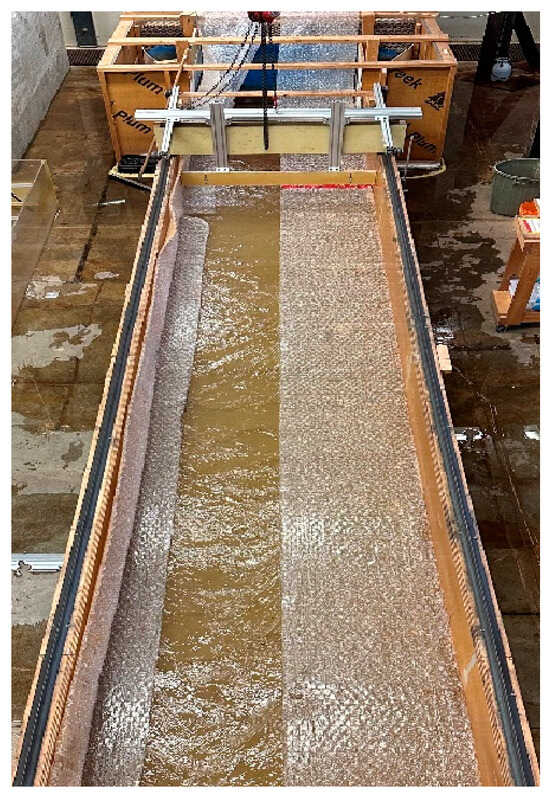
Figure 2.
Simulated ice covers for asymmetric partially ice-covered flow.
The bedload transport experiments were conducted under uniform flow conditions. This was accomplished by modifying the water depth and discharge to meet the specific requirements of each test, following the method outlined by Rouzegar and Clark [27]. Throughout all experimental runs, the water surface slope and flow depth were assessed using five 39.4 mm diameter manometer tubes installed on the flume wall, equipped with a point gauge with an accuracy of ±0.2 mm. Also, confirmation of fully developed flow was obtained by utilizing a Nortek Vectrino acoustic Doppler velocimeter to measure vertical profiles of streamwise velocity at different distances along the flume length. The duration of each test was adjusted based on the bedload transport rate, resulting in shorter test durations for higher bedload transport rates and relatively longer durations for lower bedload transport rates.
After completing each experiment, sand in different sections of the sediment trap was collected separately. The collected sand was dried in an oven at a precise temperature of 110 ± 5 °C (230 ± 9 °F) and then allowed to cool in the air at room temperature for approximately 1 ± 1⁄2 h. Subsequently, the mass of dried sand was measured with an accuracy of ±0.2 g [30]. The sediment volume was calculated knowing that the bulk density of sand was 1.5 g/cm3 (), where G is the collected and dried mass of sediment [g], V is the volume of dried sediment [m3], and is the sand bulk density. The volumetric rate of bedload transport per unit width () was then calculated using Equation (1) [31,32,33]:
where T is the sampling time [s] and b is the flume width [m].
In experiments with relatively short durations, the absence of upstream sediment supply throughout the tests has an observable impact solely at the upstream end of the channel, leaving the morphology in downstream sections and the channel’s sediment transport rates unaffected [31,34]. The test durations in the current experiments were all set to ensure the foregoing conclusion was true.
Rouzegar and Clark [27] have investigated the effect of flow strength on bedload transport rate and distribution in a symmetric partially ice-covered channel. In the current study, seven tests were designed, including four different dimensionless flow strengths (0.05, 0.06, 0.07, 0.1), two different coverage ratios (0.5, 0.67), and three different shapes of asymmetric border ice, to explore the impact of such asymmetry on bedload transport rate and distribution. The test conditions are listed in Table 1.

Table 1.
Experimental conditions (note: C = coverage ratio, Q = flow rate).
3. Results and Analysis
The influence of asymmetric border ice on bedload transport rate and distribution was investigated through a comprehensive experimental analysis of various factors and conditions.
3.1. Cross-Section-Averaged Bedload Transport Rate
For each test, dimensionless flow strength () and cross-section averaged dimensionless bedload transport rate (ϕ = ) were calculated (to calculate ϕavg, the total mass of dry sand within the entire sediment trap was taken into account.), where τb = average bed shear stress, τ = cross-sectional average shear stress (τ = γS), = the hydraulic radius, S = water surface slope, g = gravitational acceleration, D = particle diameter, and Δ = s − 1 (s = specific gravity of sediment). The calculation of the shear stress at the channel bed (τb) involved multiplying the cross-sectional average shear stress (τ) by 1.2, as suggested by Peters [35]. Peters utilized a log-law fitting procedure for comparable hydraulic conditions within the same experimental setup. Rouzegar and Clark [27] further investigated the impact of ice cover on the flow dynamics, measuring the velocity profiles for each coverage ratio using a Nortek Vectrino II profiling acoustic Doppler velocimeter (ADV), and calculated the bed shear stress distribution by fitting the log-law to each velocity profile. Since the results obtained from Rouzegar and Clark’s [27] analysis closely matched those reported by Peters et al. [1], the consistency and reliability of the findings confirm the results used in this study. The wetted perimeter and area for different conditions of asymmetric border ice are shown in Figure 3.

Figure 3.
Wetted perimeter and area for channels with asymmetric border ice.
Figure 4 compares the cross-section-averaged dimensionless bedload transport rate derived from the current set of experiments involving asymmetric border ice with data from previous studies that examined symmetric partially ice-covered, fully ice-covered, and open channel flow conditions. The figure also includes the empirical equation proposed by Knack and Shen [36] (Equation (2)). Remarkably, this empirical equation aligns fairly well with the data from the current experiments, implying that it has the capability to predict the cross-section-averaged dimensionless bedload transport rate in asymmetric partially ice-covered rivers, similar to Rouzegar and Clark’s [27] findings for symmetric border ice conditions.
where α and β = empirical coefficients and = critical dimensionless flow strength. Equation (2) was originally suggested by Chein and Wan [37]. Knack and Shen [36] empirically determined appropriate values of α and β through a range of studies (yielding ).
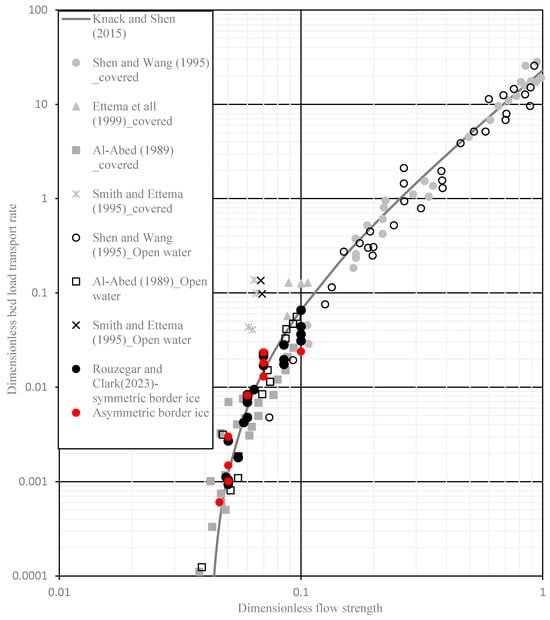
Figure 4.
Comparison of experimental data to previous studies and Knack and Shen’s equation [12,13,16,18,27,36].
It is worth noting that the experimental setup limitations, like pump capacity, measurable water depth, and measurable sand quantity, restricted the range of flow strengths. However, the available data within a limited range were considered sufficient for the study’s purposes because extremely high water velocities prevent the formation of border ice during freeze-up.
3.2. Effect of Level of Asymmetry
The effect of the level of asymmetry in partially ice-covered flow was investigated through the examination of three different experiments, wherein varying Br (border ice width on the right-hand-side of the channel) and Bl (border ice width on the left-hand-side of the channel) were considered. The data for the symmetric case is derived from the work of Rouzegar and Clark [27]. A constant coverage ratio (C = 0.5) and flow strength ( = 0.05) were maintained throughout all three tests to ensure comparability of results and facilitate the exclusive observation of the influence of the level of asymmetry. The asymmetric condition for each test is shown in Table 2. For each test, the dimensionless bedload transport rate in each bin (ϕ) and cross-section-averaged dimensionless bedload transport rate (ϕavg) were calculated, and ϕ/ϕavg was obtained.

Table 2.
Effect of level of asymmetry on bedload transport distribution.
Figure 5 illustrates the bedload transport rate distribution in the aforementioned experiments. In this figure, x represents the distance from the flume wall, and L denotes the flume width. Also, thick lines correspond to the covered sections, while the dotted line indicates the open sections. Figure 5c illustrates the bed load transport distribution across the channel width in the presence of symmetric border ice, with the peak value located at the center of the channel and the minimum value observed in the corners. The presence of symmetric border ice causes lower relative bedload transport close to the banks and greater relative bedload transport in the middle section [27]. Asymmetric border ice can cause even more redistribution in the bedload transport rate, leading to a non-uniform distribution of bedload transport across the channel width. That is, the peak values of bedload transport tend to be concentrated in the center of the open flow section rather than the center of the channel in symmetric border ice flow conditions (Figure 5a,b). The greater the level of border ice asymmetry, the more asymmetry in bedload transport rate distribution was observed. Also, the difference of ϕ/ϕavg in the open section and the covered section is more significant when the level of asymmetry increases.
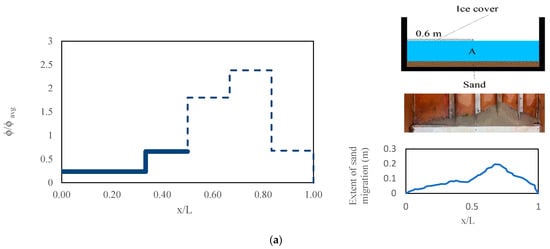
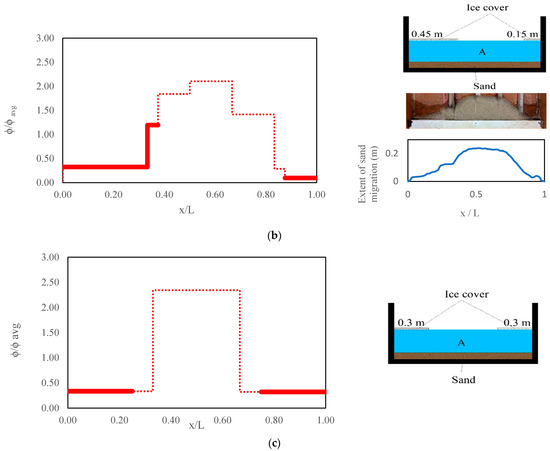
Figure 5.
Comparison of bedload transport rate distribution for constant coverage ratio (C = 0.5) and flow strength ( = 0.05) and different levels of asymmetry (a) Br = 0, Bl = 0.6 m; (b) Br = 0.15 m, Bl = 0.45 m; and (c) Br = 0.3 m, Bl = 0.3 m
Presuming that the sediment trap has been partitioned into three equally sized sections, labeled as R (right section), M (middle section), and L (left section) when observing in the downstream direction, for each section, the ratio of ϕ/ϕavg was calculated and is summarized in Table 2. As depicted in the figure adjacent to Table 2, the first test exhibits no ice cover in the right section, leading to the highest ϕR/ϕavg ratio among all tests. However, as the coverage ratio increases in the right section, the ϕR/ϕavg ratio decreases. Conversely, in the middle section, test 1 demonstrates the most substantial ice cover compared to the other tests, resulting in the lowest ϕM/ϕavg ratio, which then progressively increases from test 1 to 3. The same trend is observed for the left section. These results show that ice coverage leads to a proportionate decrease in bedload transport rate in the covered sections and a corresponding increase in bedload transport rate in the open flow section.
Figure 6 further separates out the experimental results of the three mentioned tests into the average, left, middle, and right sections, (i.e., (θavg, ϕavg), (θL, ϕL), (θM, ϕM), (θR, ϕR)). In this figure, the data for the right section is represented by “─”, the middle section by “▲”, the left section by “×”, and the average is denoted by “●”. Additionally, test number 1 is depicted in red, test number 2 in blue, and test number 3 in green.
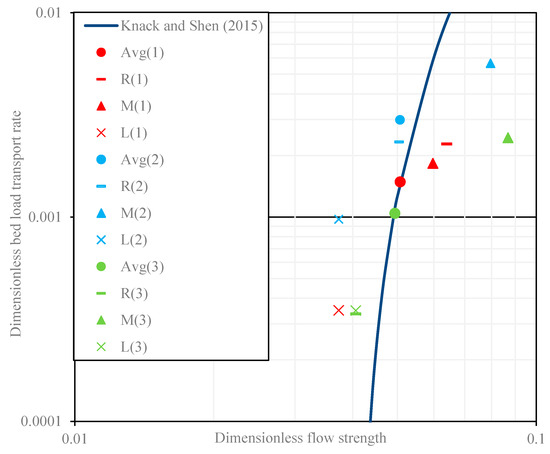
Figure 6.
Comparison of dimensionless bedload transport rate in the left, middle, and right sections of the channel [36].
A comparison of data points reveals that when a section is predominantly covered by ice in each test, the additional boundary leads to reduced flow strength and, consequently, lower ϕ values. Conversely, for open sections, the trend is reversed, resulting in higher ϕ values. Moreover, all tests (θavg, ϕavg) align with the predicted line, indicating that the equation effectively estimates the average-cross-section bedload transport rate. However, data points related to the right, middle, and left sections deviate from the line, potentially due to assumptions made in the calculation of the wetted perimeter, resulting in inaccuracies in flow strength estimation. Upon analyzing the data points, it becomes evident that for sections mainly covered by ice (L(1), L(2), L(3), R(2), R(3)), the assumed value for θ is underestimated due to an overestimation in the wetted perimeter calculation. Conversely, for open sections (M(1), M(2), M(3), R(1)), the value for θ is overestimated because of an underestimation in the wetted perimeter calculation. The reason for potential underestimation or overestimation in calculating the wetted perimeter for different sections individually is due to the exclusive consideration of the solid interface in the wetted perimeter calculation, while disregarding the water interface length between the higher momentum and lower momentum fluid.
3.3. Effect of Coverage Ratio
The effect of the coverage ratio was investigated by comparing two groups of tests under symmetric [27] and asymmetric conditions (Figure 7). In each group of the test, flow strength was kept constant while varying the coverage ratio. The results showed that increasing the coverage ratio caused an increase in ϕ/ϕavg in the central section, while it caused a decrease in ϕ/ϕavg in the side sections for both symmetric and asymmetric conditions. These findings confirm that ice coverage contributes to a relative reduction in bedload transport rate in the covered sections and a relative increase in bedload transport rate in the open flow section. Also, as the coverage ratio increased, there was a greater redistribution in bedload transport, resulting in a less uniform f distribution along the cross-section.
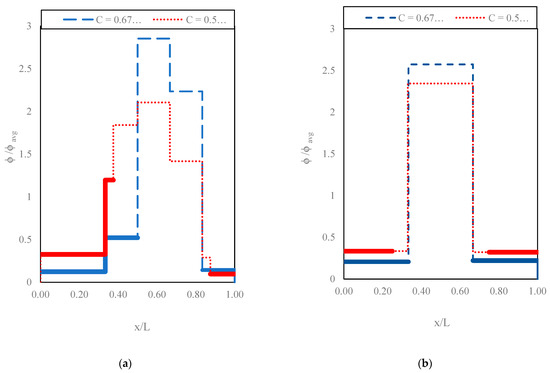
Figure 7.
Comparison of bedload transport rate distribution for constant flow strength ( = 0.05) and different coverage ratios for (a) asymmetric border ice (Br/Bl = 1/3); and (b) symmetric border ice (Br/Bl = 1). (Note: Bold line corresponds to the ice-covered portion, and the dashed lines the open water portions.)
3.4. Effect of Flow Strength
Rouzegar and Clark [27] demonstrated that in rivers characterized by symmetric border ice for a constant coverage ratio and high dimensionless flow strength, the difference of bedload transport rate in the middle section and the side sections wasn’t significant. However, at low dimensionless flow strengths, the relative bedload transport rates at the sides were significantly lower than those in the middle. This is presented in Figure 8, where the high flow strength experiment has open water and ice-covered value of ϕ/ϕavg of 1.41 and 0.84, respectively; while the lowest flow strength experiment covers a much greater range of ϕ/ϕavg from 2.57 to 0.2. Careful inspection of all the experiments will reveal that the flow wasn’t perfectly symmetric, despite controlling the experimental conditions as carefully as possible.
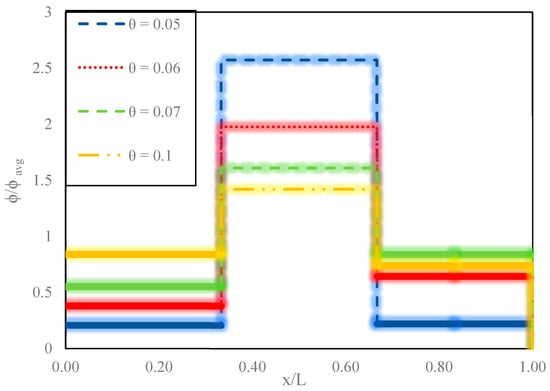
Figure 8.
Comparison of bedload transport rate distribution for constant coverage ratios (C = 0.67) at different flow strengths in a symmetric partially ice-covered river. (Note: Bold line corresponds to the ice-covered portion, and the dashed lines the open water portions.).
The effect of flow strength in asymmetric partially ice-covered flow was studied by analyzing five distinct experiments, all maintaining a constant coverage ratio (C = 0.67), constant level of asymmetry (Br/Bl = 1/3), and different flow strengths. Figure 9 shows the bedload transport rate distribution in these experiments. On the left-hand side of the figure, sediment trap pictures were included to visually demonstrate the continuous data. Additionally, a blue line was included to aid in identifying the extent of the deposited sediment. Similar to symmetric experiments, the effect of border ice on bedload transport rate distribution is more noticeable in the low flow strength. That is, the range of ϕ/ϕavg spans from 0.12 to 2.85 at the lowest flow strength and from 0.59 to 1.65 at the highest flow strength. Furthermore, the impact of asymmetry in border ice is more significant at lower flow strength. Examining the figures on the left-hand side, at the lowest flow strength, the maximum extent of migration occurred in the middle of the open section. In contrast, for other cases, the maximum value was located in the middle of the channel, and the effect of asymmetry was less noticeable. The figure on the right-hand side demonstrates similar results for ϕ/ϕavg. Focusing on the middle sections, specifically the regions where 0.33 < x/L < 0.5 (ice-covered flow) and 0.5 < x/L < 0.67 (open flow), at the lowest flow strength the difference in ϕ/ϕavg between these two sections was significant (ϕ/ϕavg = 0.52 and 2.85). However, this difference is not as noticeable at the highest flow strength (ϕ/ϕavg =1.05 and 1.65), and the distribution appears to be more symmetrical. It is worth noting that each experiment had a different duration, resulting in a variable total sediment volume.
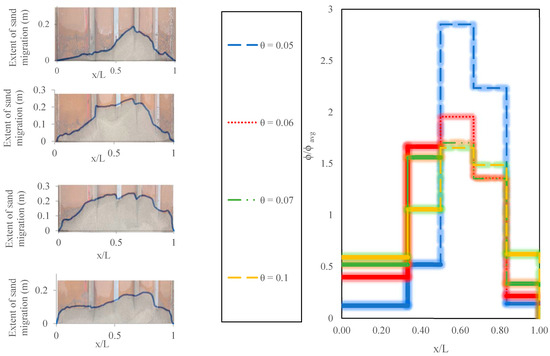
Figure 9.
Comparison of bedload transport rate distribution for constant coverage ratios (C = 0.67), constant asymmetric level (Br/Bl = 1/3), and different flow strength in an asymmetric partially ice-covered river, (Note: Bold line corresponds to the ice-covered portion, and the dashed lines the open water portions.).
4. Discussion
The presence of border ice introduces a complex dynamic to sediment transport rates in northern rivers. The findings from the current experiments serve as a benchmark for numerical investigations into sediment transport in rivers with partial ice cover. These results offer a more accurate quantification of sediment transport likelihood in a diverse range of northern climate rivers. Specifically, they enable the estimation of which portions of a channel cross-section would experience the highest sediment transport. In this study, the research did not delve into the process of border ice growth, nor did it explore the real-world impact of sediment transport mechanisms. Instead, the primary focus was on presenting the initial quantitative results related to bedload transport under asymmetric partially ice-covered conditions that might happen in real-world situations and then comparing the result with the symmetric conditions.
The initiation of border ice occurs along the riverbanks. Following the initial formation, this border ice horizontally extends towards the center of the channel while simultaneously thickening as it grows vertically downwards. In addition to the freeze-up season, the main section of the channel may open up and result in a partial ice cover during midwinter thaw events (Figure 10). It is important to note that partial ice cover is not always symmetrical in real-world scenarios. Asymmetry can arise due to variations in the river cross-section, leading to uneven water velocity distribution across the channel and resulting in asymmetric partial ice cover. Meandering rivers, for instance, exemplify this situation, where both the velocity profile within the cross-section and along the river’s length are not symmetric, potentially giving rise to asymmetric partial ice cover (Figure 10). Although the current research did not specifically consider meandering rivers, the findings indicate that asymmetric border ice conditions can significantly impact sediment transport rate redistribution. Consequently, a potential avenue for future research involves extending this study to include different types of rivers, such as meandering rivers, to further explore the effects of asymmetric border ice on sediment transport.

Figure 10.
Asymmetric partially ice cover in meandering river: (a) Dauphin River, Manitoba, Canada, Dec 2014 (freeze-up season) (Images courtesy of S. Clark and A. Wall); (b) Bulkley river, British Columbia, Apr 2023 (beak-up season) (Images courtesy of USGS).
The growth of border ice involves two primary mechanisms: thermal growth and frazil accretion, commonly known as buttering. Border ice expands through these processes, resulting in diverse surface textures based on the chosen growth method. Irregular undersurfaces may be observed, especially in frazil accretion or freeze-up jam formation. Consequently, investigating the impact of varying ice roughness on sediment transport rates presents an intriguing avenue for future research.
Blackburn and She [38] improved the River1D river ice model for natural channel geometry and freeze-up, incorporating border ice formation. Integrating current experimental results into River1D is challenging due to cross-sectional averaging, particularly with sediment transport redistribution across asymmetric ice cover. Alternatively, better integration potential exists in two-dimensional river ice models, like CRISSP2D [39] and RIVER2D [40].
5. Conclusions
This research aimed to investigate bedload transport rate and distribution in channels with asymmetric partial ice cover. Controlled laboratory experiments were conducted to achieve this objective, examining bedload transport under various conditions. The study specifically assessed the applicability of the Knack and Shen [36] formula for estimating the total cross-section-averaged bedload transport rate in asymmetric partially ice-covered rivers. Remarkably, the experimental findings for asymmetric border ice aligned with Knack and Shen’s equation [36], originally developed for open channel and fully ice-covered flow, as well as the findings of Rouzegar and Clark [29] for symmetric partially ice-covered flow. This indicates that the empirical equation may be suitable for predicting cross-section-averaged bedload transport in rivers with different types of border ice cover. However, this equation lacks precision in predicting the extent of sediment transport redistribution beneath a partial ice cover.
According to Rouzegar and Clark [27], the presence of symmetric border ice results in lower relative bedload transport near the banks and higher relative bedload transport in the middle section of the channel. However, the situation becomes even more complex with asymmetric border ice, leading to further redistribution in the bedload transport rate and causing a non-uniform distribution of bedload transport across the channel width. Furthermore, this redistribution is more pronounced at higher flow strengths and less noticeable at lower flow strengths. Our ability to model this variation in bedload transport rate likely hinges on the ability to accurately predict the boundary shear stress distribution throughout the entire wetted perimeter of the channel. This may be easier when using a two dimensional numerical model. The experimental results from this study comprise the only data source for potential assessment or validation of numerical model ability to predict bedload transport rate in channels with asymmetric border ice.
Author Contributions
Conceptualization, M.R.; Methodology, M.R.; Validation, M.R.; Formal analysis, M.R.; Investigation, M.R.; Resources, S.P.C.; Data curation, M.R.; Writing—original draft, M.R.; Writing—review & editing, S.P.C.; Supervision, S.P.C.; Funding acquisition, S.P.C. All authors have read and agreed to the published version of the manuscript.
Funding
This research was supported by the Natural Sciences and Engineering Research Council of Canada (NSERC-RGPIN-2018-06448).
Data Availability Statement
Data available on request from the authors.
Acknowledgments
The authors would like to acknowledge Alexander Wall for his assistance with the experimental setup.
Conflicts of Interest
The authors declare no conflict of interest.
References
- Peters, M.; Dow, K.; Clark, S.P.; Malenchak, J.; Danielson, D. Experimental investigation of the flow characteristics beneath partial ice covers. Cold Reg. Sci. Technol. 2017, 142, 69–78. [Google Scholar] [CrossRef]
- Clark, S. Border and Skim Ice. In River Ice Formation; Beltaos, S., Ed.; Committee on River Ice Processes and the Environment: Edmonton, AB, Canada, 2013; pp. 77–106. [Google Scholar]
- Nyantekyi-Kwakye, B.; Essel, E.E.; Dow, K.; Clark, S.P.; Tachie, M.F. Hydraulic and turbulent flow characteristics beneath a simulated partial ice-cover. J. Hydraul. Res. 2021, 59, 392–403. [Google Scholar] [CrossRef]
- Peters, M.; Clark, S.P.; Dow, K.; Malenchak, J.; Danielson, D. Flow Characteristics beneath a Simulated Partial Ice Cover: Effects of Ice and Bed Roughness. J. Cold Reg. Eng. 2018, 32, 1. [Google Scholar] [CrossRef]
- Kimiaghalam, N.; Clark, S.; Dow, K. Estimation of Shear Stress Distribution in a Partially-Covered Channel. In Proceedings of the CGU HS Comm. River Ice Process. Environ. 19th Workshop, Hydraulics of Ice-Covered Rivers, Whitehorse, YT, Canada, 9–12 July 2017. [Google Scholar]
- Majewski, W. Laboratory investigation of the flow in open channels with partial ice cover. In Proceedings of the 11th International Symposium on Ice, Banff, AB, Canada, 15–19 June 1992; pp. 335–345. [Google Scholar]
- Essel, E.E.; Clark, S.P.; Dow, K.; Tachie, M.F. Experimental and numerical investigation of three-dimensional open channel with simulated partial ice-covers. J. Hydraul. Res. 2021, 59, 977–988. [Google Scholar] [CrossRef]
- Ettema, R.; Daly, S.F. Sediment Transport under Ice; US Army Engineer Research and Development Center, Cold Regions Research and Engineering Laboratory: Hanover, NH, USA, 2004. [Google Scholar]
- Lawson, D.E.; Chacho, E.F., Jr.; Brockett, B.E.; Wuebben, J.L.; Collins, C.M.; Arcone, S.A.; Delaney, A.J. Morphology, Hydraulics, and Sediment Transport of an Ice Covered River: Field Techniques and Initial Data; U.S. Army Cold Regions Research and Engineering Laboratory: Hanover, NH, USA, 1986. [Google Scholar]
- Wuebben, J.L. Effects on an ice cover on flow in a movable bed channel. In Proceedings of the 9th International Symposium on Ice, IAHR, Sapporo, Japan, 23–27 August 1988; pp. 137–146. [Google Scholar]
- Wuebben, J.L. A laboratory study of flow in an ice-covered sand bed channel. In Proceedings of the 8th International Symposium on Ice, IAHR, Iowa City, IA, USA, 18–22 August 1986; pp. 3–14. [Google Scholar]
- Shen, H.T.; Wang, D.S. Under Cover Transport and Accumulation of Frazil Granules. J. Hydraul. Eng. 1995, 121, 184–195. [Google Scholar] [CrossRef]
- Al-Abed, N.M.A. Sediment Transport under Ice Covered Channels. Ph.D. Dissertation, University of Kashmir, Srinagar, India, 1989. [Google Scholar]
- Muste, M.; Braileanu, F.; Ettema, R. Flow and sediment transport measurements in a simulated ice-covered channel. Water Resour. Res. 2000, 36, 2711–2720. [Google Scholar] [CrossRef]
- Ettema, R.; Braileanu, F.; Muste, M. Method for Estimating Sediment Transport in Ice-Covered Channels. J. Cold Reg. Eng. 2000, 14, 130–144. [Google Scholar] [CrossRef]
- Ettema, R.; Braileanu, F.; Muste, M. Laboratory Study of Suspended Sediment Transport in Ice-Covered Flow Laboratory Study of Suspended Sediment Transport in Ice-Covered Flow; University of Iowa: Iowa City, IA, USA, 1999. [Google Scholar]
- Sayre, W.W.; Song, G.B. Effects of Ice Covers on Alluvial Channel Flow and Sediment Transport Processes; Iowa Institute of Hydraulic Research: Iowa City, IA, USA, 1979. [Google Scholar]
- Smith, B.T.; Ettema, R. Ice-Cover Influence on Flow and Bedload Transport in Dune-Bed Channels; IIHR Rep. No. 374; Iowa Institute of Hydraulic Research, University of Iowa: Iowa City, IA, USA, 1995. [Google Scholar]
- Meyer-Peter, E.; Muller, R. Formulas for bed-load transport. In Proceedings of the 2nd Meeting of IAHR, Stockholm, Sweden, 7 June 1948; pp. 39–64. [Google Scholar]
- Einstein, H.A. The Bed-Load Function for Sediment Transportation in Open Channel Flows; Technical Bulletin 1026; U.S. Department of Agriculture: Washington, DC, USA, 1950. [Google Scholar]
- Carr, M.L.; Tuthill, A.M. Modeling of Scour-Inducing Ice Effects at Melvin Price Lock and Dam. J. Hydraul. Eng. 2012, 138, 85–92. [Google Scholar] [CrossRef]
- Kolerski, T.; Shen, H.T. Possible effects of the 1984 St. Clair river ice jam on bed changes. Can. J. Civ. Eng. 2015, 42, 696–703. [Google Scholar] [CrossRef]
- Manolidis, M.; Katopodes, N. Bed scouring during the release of an ice jam. J. Mar. Sci. Eng. 2014, 2, 370–385. [Google Scholar] [CrossRef]
- Yang, X.; Zhang, B.; Shen, H.T. Simulation of wintertime fluvial processes in lower Yellow River. J. Sedimentary Res. 1993, 2, 36–43. [Google Scholar]
- Knack, I. Mathematical Modeling of River Dynamics with Thermal-Ice-Sediment Processes; Clarkson University: Potsdam, NY, USA, 2011. [Google Scholar]
- Knack, I.M.; Shen, H.T. A numerical model for sediment transport and bed change with river ice. J. Hydraul. Res. 2018, 56, 844–856. [Google Scholar] [CrossRef]
- Rouzegar, M.; Clark, S.P. Experimental investigation of sediment transport in partially ice-covered channels. Int. J. Sediment Res. 2023, 38, 769–779. [Google Scholar] [CrossRef]
- Rouzegar, M.; Clark, S. Experimental Investigation of Asymmetric Border Ice Effect on Sediment Transport. In Proceedings of the 40th IAHR World Congress, Vienna, Austria, 21–25 August 2023. [Google Scholar]
- Rouzegar, M.; Clark, S.P. Sediment transport rate estimation in partially ice-covered channels. In Proceedings of the 26th IAHR International Symposium on Ice, Montreal, QC, Canada, 19–23 June 2022. [Google Scholar]
- ASTM C128-15; Standard Test Method for Density, Relative Density (Specific Gravity) and Absorption of Fine Aggregates. ASTM International: West Conshohocken, PA, USA, 2015.
- Khosravi, K.; Chegini, A.H.; Cooper, J.R.; Daggupati, P.; Binns, A.; Mao, L. Uniform and graded bed-load sediment transport in a degrading channel with non-equilibrium conditions. Int. J. Sediment Res. 2020, 35, 115–124. [Google Scholar] [CrossRef]
- Nezu, I.; Rodi, W. Open-channel flow measurements with a laser doppler anemometer. J. Hydraul. Eng. 1986, 112, 335–355. [Google Scholar] [CrossRef]
- Tsai, W.; Ettema, R.; Tsai, A.M.W.; Member, A.A. Modified eddy viscosity model in fully developed asymmetric channel flows. J. Eng. Mech. 1994, 120, 720–732. [Google Scholar] [CrossRef]
- Binns, A.D.; da Silva, A.M. On the Quantification of the Bed Development Time of Alluvial Meandering Streams. J. Hydraul. Eng. 2009, 135, 350–360. [Google Scholar] [CrossRef]
- Peters, M. An Experimental Study of the Hydraulic Characteristics Beneath a Partial Ice Cover; University of Manitoba: Winnipeg, MB, Canada, 2015. [Google Scholar]
- Knack, I.; Shen, H.-T. Sediment transport in ice-covered channels. Int. J. Sediment Res. 2015, 30, 63–67. [Google Scholar] [CrossRef]
- Chein, N.; Wan, Z. Mechanics of Sediment Transport; ASCE Press: Reston, VA, USA, 1999. [Google Scholar]
- Blackburn, J.; She, Y. A comprehensive public-domain river ice process model and its application to a complex natural river. Cold Reg. Sci. Technol. 2019, 163, 44–58. [Google Scholar] [CrossRef]
- Shen, H.T. Development of a comprehensive river ice Simulation system. In Proceedings of the 16th IAHR International Symposium on Ice, IAHR, Dunedin, New Zealand, 2–6 December 2002; pp. 142–148. [Google Scholar]
- Steffler, P.; Blackburn, J. River2D: Two-Dimensional Depth Averaged Model of River Hydrodynamics and Fish Habitat, Introduction to Depth Averaged Modeling and User’s Manual; University of Alberta: Edmonton, AB, Canada, 2002. [Google Scholar]
Disclaimer/Publisher’s Note: The statements, opinions and data contained in all publications are solely those of the individual author(s) and contributor(s) and not of MDPI and/or the editor(s). MDPI and/or the editor(s) disclaim responsibility for any injury to people or property resulting from any ideas, methods, instructions or products referred to in the content. |
© 2023 by the authors. Licensee MDPI, Basel, Switzerland. This article is an open access article distributed under the terms and conditions of the Creative Commons Attribution (CC BY) license (https://creativecommons.org/licenses/by/4.0/).
